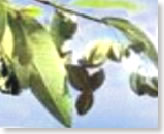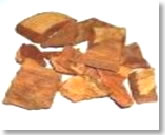
ARJUNA
Botanical Name: Terminalia arjuna (COMBRETACEAE)
English Name: Arjun tree
Hindi Name: Arjun

Introduction: in Rigveda, the word Arjuna is used (R.V.1/122/5). Hindu mythology documented that this tree has its origin when lord Indra Killed a gaint by name Vritra. Charaka considered this as Udarda pprasamana ( anti-allergic). It is used in heart disease, respiratory diseases, diabetes, wounds etc. Distribution: It is large tree which is found throughout India upto 4500 feet in the hills. Now it is found cultivated in gardens & forests mainly. Chemical Constituents: arjunic acid, arjunone, arjunetin, arjunolone, arjuglucosides I & II, arjunoside, tannins etc. Parts Used: Stem bark Properties: astringent, cooling, cardioprotective, antiplatelet, hypolipidemic, hypotensive, hypoglycemic activities etc. Indications: Heart diseases, respiratory diseases, fractures, wounds, obesity etc. Dose: Powder 3-6 g: decoction 50-100 ml. Therapeutic Uses: Urinary infections: Decoction of arjun bark is given orally. Heart diseases: Milk shake made with arjuna bark is given. Scientific Studies: Lipid lowering effect: Marked reduction in total cholesterol and increase in HDL are reported {Jr. Rs. Educ.Ind. Med., Oct-Dec. 1988. P. 31-36}. Serum lipids were found to be lowered by administration of bark powder of T. arjuna ( 100mg/kg b.w) in triton induced hyperlipidemia. The lipid lowering action of this natural product was found to be mediated through inhibitionof hepatic cholesterol biosyntheses, increased fecal bile acid excretion and enchanced plasma lecithin, cholesterol acyltransferase activity and stimulation or receptor mediated catabolism of LDL. [Khanna A.K. et al., ; Phytotherapy Res., Vol. 10 (8) : p. 663-665, 1996]. 50% EE in doses of 100 mg/kg (group B) and 500 mg/kg (group C) showed marked reduction in cholesterol levels after 60 days when compared with controls (groupA) –[Ram A.; J. of Ethnopharmacol., 55(3) : p.165-169, 1997]. Stem bark (500 mg/kg) reduced the cholesterol, phospholipid and TG serum, levels significantly in test animals [Shaila H.P. et al., Fitotherapia, 68(5): p. 405-409, 1997]. Cultivation Technology: It can be artificially propagated through seeds, coppicing, pollarding, root-suckers, stumps and air-layering. Shoot multiplication from nodal explants was achieved by culturing an Murashige and Skoog (MS) medium containing different concentrations of 6-benzyladenine {BA), thidiazuron or kinetin,or BA in combination with *napthaleneacetic acide [NAA). The best shoot multiplication response was obtained from nodal explants grown on modified MS (half-strength major salts and Fe-EDTA) medium containing 4.44 *MBA and 0.53 * MNAA. Seasnal variations significantly affected the proliferation was observed from explants collected during April to May. Harvesting: It is initially slow-growing . It attains 23m height in 3 years. Arjun yields up to 45 kg dry bark chips on a three year cycle without injury.







